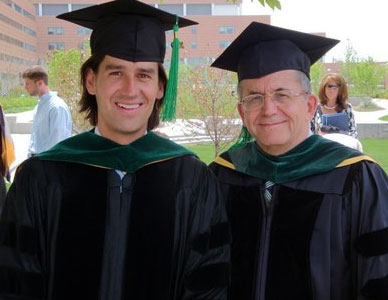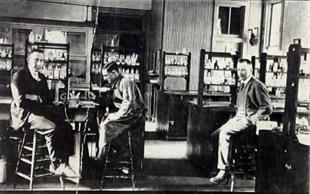All in the Family
Four generations of CU School of Medicine physicians
Chris Casey
 (May 2017) The Kenagy-Vance family line of physicians stretches across states, continents generations, but a common thread connects them: the University of Colorado School of Medicine.
(May 2017) The Kenagy-Vance family line of physicians stretches across states, continents generations, but a common thread connects them: the University of Colorado School of Medicine.
Four generations of men in the Kenagy-Vance family have cared for patients in Switzerland, Pennsylvania, Idaho, Minnesota and points beyond after earning medical degrees from the University of Colorado.
John Brough “JB” Kenagy started it all in 1906 when he graduated from the School of Medicine – then located in Boulder.
The next two physicians in the family – Fayre H. Kenagy (class of 1920) and J. Corwin (Corky) Vance (class of 1971) – attended the medical school in Boulder and then the CU Health Sciences Center in Denver, respectively.
The gap between medical school graduates Fayre and Corky is because Corky’s father, Edward Pershing Vance, who married Barbara Eloise Kenagy, chose a different path: He pursued a successful career in natural resource stewardship in the Pacific Northwest.
Karl Kenagy Vance, son of Corky and Karen Vance, extended the family’s black-and-gold bond into the 21st century by attending medical school at the CU Anschutz Medical Campus from 2005 to 2009. Karl had applied to about 10 medical
“The combination of the high-quality education at the medical school and the lifestyle of being in Colorado factored in,” said Karl, who is an avid cyclist and skier. “Also, it was something I thought would be cool – that I would be the fourth generation of my family to go to the CU School of Medicine.”
Before CU
The history of physicians in the family dates back to Bern, Switzerland, where Corky’s sixth great-grandfather, Hans Gnage, practiced medicine before fleeing the country at a time when Mennonites faced religious persecution.
“Family legend has him seeing a patient when the police came to arrest him for draft evasion,” Corky said. “His wife had the policeman sit down to wait for him and offered food and drink, but then sent their son to tell his father to leave the country instead of coming home. His family joined him later.”
Hans arrived in Pennsylvania in 1742, joined the Amish community, and resumed work as a physician. It would be several generations later when JB Kenagy, born and raised in a Mennonite community in Ohio, and already established in a career as an educator would carry on the family tradition of medicine.
JB studied at the Kansas Normal School in Fort Scott, then moved to Colorado to teach, first in Buena Vista for four years, then for three years in Gunnison, where he was the principal. He then decided to become a physician, moved to Boulder and entered CU medical school and graduating in 1906 at age 43. He moved to Rupert, Idaho, to practice internal medicine. JB’s son, Fayre Kenagy, aspired to become a doctor like his father. Though he was drafted into the military during World War I, he
Keeping the CU tradition going
 Fayre delivered J. Corwin Vance in August 1945, starting a lifelong bond with the boy who went by the nickname Corky.
Fayre delivered J. Corwin Vance in August 1945, starting a lifelong bond with the boy who went by the nickname Corky.
“I was in awe of my grandfather and wanted to follow in his footsteps. I therefore also attended the CU medical school,” Corky said. “When Karl was born, we named him Karl Kenagy Vance, after his great-grandfather. He later decided to attend the CU medical school as well, having heard how great it was.”
Corky Vance is now retired, but Karl worked with his father during the final year of his practice in Minneapolis. Karl now works with several of Corky’s longtime staff members, though in a different dermatology practice.
The Twin Cities are a fitting home for the father and son because they have paired interests in fine food and wine and in international travel. When Corky and Karl aren’t pursuing culinary interests, you might find them on their bicycles or in planes traveling the world. Sometimes they’re globetrotting and cycling – as they did on a family trip to Italy last fall.
Both father and son met their wives while attending the CU medical school. Corky met his wife, Karen, while she was a lab technician, and Karl connected with Pamela while out on the town with classmates.
Just as Corky was inspired to pursue medicine by his grandfather, Karl looked up to his father, who became the first dermatologist in the Twin Cities to perform Mohs surgery – a micrographic procedure that removes skin cancers.
“He found it rewarding. Growing up around medicine, you get an understanding of the process, the responsibilities and the ups and downs of it,” Karl said. “Mostly, it’s a fulfilling career because it’s a daily opportunity to help people.”
Camaraderie with CU classmates
Karl enjoyed the camaraderie with his classmates at CU Anschutz after struggling to connect with pre-med classmates at Stanford University. He excelled in chemical engineering, and it wasn’t long before he connected that discipline to a growing interest in wine. After graduating from Stanford, he became an assistant
At CU Anschutz, Karl loved his classmates. “It was hard to find people who weren’t into skiing and biking,” he said.
While in school, he was influenced by J. Ramsey Mellette, MD, the faculty member who trained him on Mohs surgery. Back in the 1970s when Corky first performed Mohs, it was a new and innovative procedure. “Now, this procedure is pretty widespread,” Karl said. “I like it because of the precision in which we take
Finding a mentor
Corky was inspired to pursue dermatology by Robert Goltz, MD, who in the late 1960s served as head of the Department of Dermatology in the medical school. Corky so enjoyed Goltz’s teaching that he took the professor’s early-morning class on public health.
“Dr. Goltz noticed that I was a hard worker, that I liked dermatology and was good at it,” Corky said. “I was good at visual learning, and that’s why dermatology appealed to me. You have to be able to memorize what rashes and other conditions on the skin look like.”
Goltz proved to be the catalyst for Corky’s career in Minnesota. Goltz, who had just accepted a job as chair of dermatology at the University of Minnesota, suggested Corky pursue his residency in the Land of 10,000 Lakes. Now, as Corky and Karen settle into retirement, they watch their progeny carry on the Kenagy-Vance caregiver tradition. Karl has established his own thriving practice in Minneapolis, while his sister Chardonnay, who attended medical school at Wake Forest University, is a family practice doctor.
“The most important thing is your job,” Corky said. “If you have a miserable job, you’ll be miserable wherever you are. If you have a rewarding job – as we are lucky enough to have – you’ll be happy.”